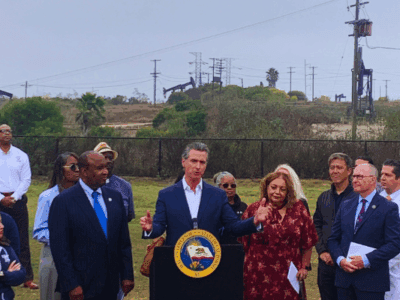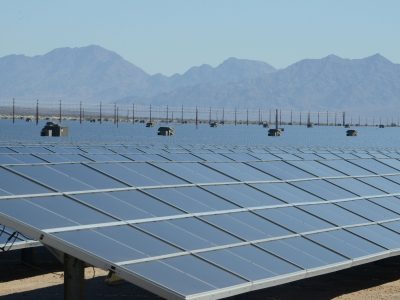Small Hands/Small Infrastructure
It’s not really an infrastructure plan. It’s a plan for toll road and local tax hikes.
The initial response to Trump’s infrastructure plan has been justifiably critical. Jennifer Rubin, my favorite conservative columnist, says the plan doesn’t pass the straight-face test. A good deal of it is designed to encourage privatization of infrastructure or to eliminate environmental safeguards for new projects. I want to focus on a different aspect of the plan, however, the focus on revenue generation. Or in other words, user fees and beneficiary taxes, whether paid to state governments or private firms. In the case of a road, for instance, the new revenue would come from tolls or from taxing nearby residents or businesses whose property values are increased by the new road.
This is a feature of the plan that has been a bit misunderstood. Many reports say the plan will cover 20% of the cost of new infrastructure. That’s not right. If you look at p. 5 of the full text, it says that grants for projects will be limited to 20% of planned new revenue, not project cost. That may be confusing, so here’s an example.
Let’s say a state wants to build a road, partly using existing revenue sources and partly tolls. The project will cost $100 million and $60 million will be funded by bonds backed by tolls. The amount of the federal grant will be 20% of $60 million, or $12 million — not 20% of the total project cost, which would be $20 million in this example. So at the end of the day, the state would get $60 million based on the tolls, $12 million from the feds, and $38 million from other revenue sources like the state’s general budget.
Thus, the amount of the grant is based on the amount of the anticipated tolls or taxes used to finance a project, not on the cost of the project. The proposed infrastructure plan uses a point system to choose projects for funding. When states apply for funding under the plan, half of the points awarded in assessing grant applications will turn on the plan for generating the new revenue. The way you get new revenue for infrastructure projects is that you charge people for them. (Maybe the plan also encompasses dedicated tax increases for infrastructure projects, although it’s hard to imagine that this proposal is really a backdoor way of getting states to pass new taxes.)
Just because Trump advocates something, it’s not necessarily a bad idea. What are the pros and cons of user fees?
Pro. On the positive side, they help prevent congestion or overuse of a resources. In equity terms, they also ensure that more of the cost of the project is placed on the people using the project, which has some appeal as a matter of equity. There is a standard (if controversial) argument for using fees to reduce traffic and pollution in central cities, for instance. Also, if governments are subject to tax or budget ceilings, it may provide a way for them to float bonds for projects or otherwise finance them.
Con. Revenue-based financing can distort the choice of projects and the mix of users. It’s easier to collect revenue for some things than others — limited access highways, for instance, as opposed to city streets. Also, part of the argument for public support for infrastructure is that infrastructure projects have positive externalities. Roads create benefits for communities, not just for the people using the roads. So revenue-based financing favors projects where most of the benefits go to the users rather than to communities, and it also encourages use of a facility by that class of users as opposed to users who experience a smaller share of the benefits created by the use. State and local governments are likely to find fees most appealing on infrastructure that has a high proportion of out-of-state users. And, obviously, there’s an equity effect on poorer users, who will either not use it or have to pay in effect a regressive tax.
My “con” list is longer, but that’s not necessarily decisive. For some particular projects, pricing the use of the infrastructure might be a good choice. But definitely not always. The same is true of privatizing infrastructure — it might work in some circumstances, but there are obvious risks of mismanagement, corruption, and inefficiency. And since a lot of infrastructure conveys some kind of monopoly power — think of a town’s water company– you need some kind of public-utility regulation to supervise pricing.
There are somewhat similar issues about another aspect of the proposal, calling for special taxes to recover the value added to property located near projects. These have the additional disadvantage that they are hard to apply to repair projects, which may be needed more than new construction.
In any event, whatever the merits of these ideas might be, it’s hard to think that this plan is going to produce a big rush of new infrastructure projects. First, at least some projects that would have been built anyway will qualify for funding. Second, at least some of the funding is going to come from cutting existing infrastructure projects. Third, there may well be local resistance to tolls and fees. The government funding may make the fee in effect 20% lower than it would have been otherwise, but that still may not be acceptable. Fourth, because the proposed federal funding is based on new revenue rather than total cost, it actually discourages states from using existing revenues to finance projects.
What about the effort to streamline permitting and environmental reviews? I have no reason to doubt that some greater efficiencies and streamlining are possible without sacrificing environmental quality. But obviously this isn’t something you’d entrust to the current Administration.
I’m sure conservative Republicans are going to like the privatization and deregulatory parts of the plan. The end result will probably be less federal funding for infrastructure than we had before, which conservatives might also like. But it’s hard to see how anything remotely like this gets sixty votes in the Senate. It’s too bad that Trump’s pledge to fund new infrastructure has come to this, given that there’s an urgent need to invest more in our country’s aging infrastructure.
Reader Comments
4 Replies to “Small Hands/Small Infrastructure”
Comments are closed.







This post is more of rapidly growing proof that Trump 2018 is the new era of American Oligarchy overruling American Democracy as another consequence of Trump 2017 replacing the Rule of Law with the Rule of Money.
When are we going to produce leaders that will lead America to invest in quality of life before global warming destroys too many opportunities to protect the human race from oligarchs like Trump?
One other post was published by Huffington Post this morning that is just as disturbing:
TV Networks Did A Really Crap Job Reporting On Climate Change Last Year
“The networks undercovered or ignored the ways that climate change had real-life impacts on people.”
https://www.huffingtonpost.com/entry/us-television-climate-change_us_5a822ff0e4b01467fcf0892b?ncid=inblnkushpmg00000009
When are intellectuals going to learn to inform, educate and motivate the public to save our environment, or are you going to continue on your own path of denial documented by Richard Hofstadter in 1963 (also quoted by Dirks in 2013) “— so many intellectuals don’t want to take on the sort of complications and impurities that come with being public.”!?
P.S. It has become impossible to determine which institution is more responsible for the destruction of our civilization today, politicians who are controlled by the power of money that is destroying our democracy or scholars who are dominated by the power of money that is destroying our environment, especially since “so many intellectuals don’t want to take on the sort of complications and impurities that come with being public.” But both are responsible.
Prof. Farber, with all due respect, I have 80 years of life experiences, including being a fan of Legal Planet for about a decade and continuous learning from one heck of a lot of never-ending reading, discussing and thinking, and I must emphasize more than I ever have before that the human race is in grave jeopardy of global warming disaster in this century.
There have been far too many warnings (Keeling, the Durants, Eisenhower, Wilson, Legal Planet, IPCC, CALIFORNIA Global Warning 2006 Special Issue and many others who are the best experts ever) for far too many decades and either we find a successful way to motivate the peoples of the world to save our civilization with the greatest urgency or we shall fail to survive with an acceptable quality of life.
It Is way past due time for academics to join together and overcome Hofstadter’s indictment or have to explain your failures to your grandchildren when they have nothing to look forward to.
There are no people on this planet who are better at making the right things happen.
FINAL CONCLUSION:
We keep proving daily that the ultimate failure mode for our civilization is THE POWER OF MONEY that controls our politicians and intellectuals, resulting in Out of Control Global Warming, Violence and Inequalities